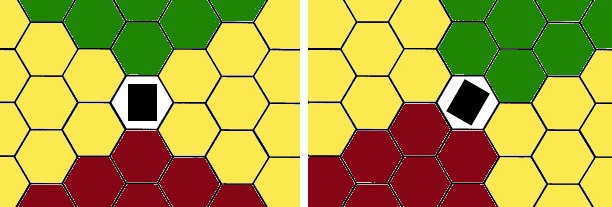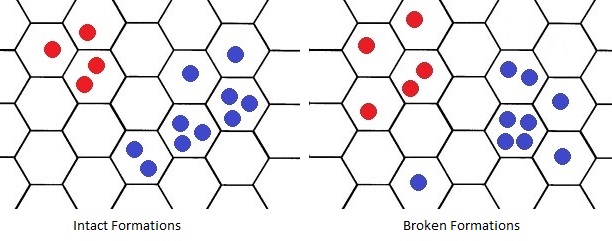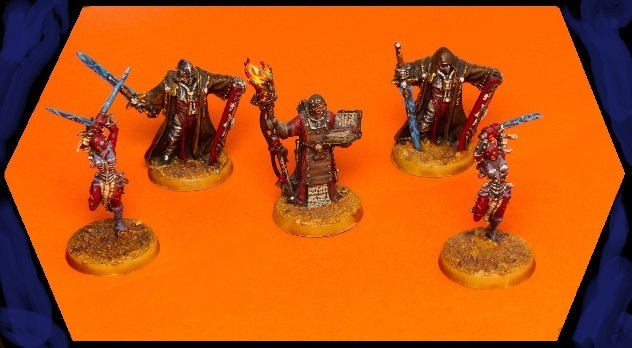A short time ago there was a discussion on 4chan’s /tg/-board about how to convert 40k to utilize a hex grid. I found the discussion itself to be pretty boring in fact, but it gave me the idea for a conversion of my own. Of course, some general tactics and the relative power of units will change under this conversion, and I probably have forgotten some scenarios, which might lead to some open rules questions.
The first important thing is the size of the hexes. One hex has to be at least 6 inches from one edge to the opposing edge, so one hex will be big enough to hold one vehicle and a few miniatures. Every hex has to provide the same hazards and benefits for all models within the hex. The position of a model within the hex is not of importance. The only thing which is important is the facing of vehicles, which works as shown in the picture below. The vehicle can either face the edge or the angle of the hex. The green area is the front, the yellow the sides and the red is the rear of the vehicle.

Smaller miniatures fit into the hexes as follows: The number of models allowed in a single hex is determined by the models’ base size. Six models with standard infantry (25 mm diameter) or small flying bases can fit into one hex. Miniatures with Terminator (40 mm diameter), cavalry or bike bases count as two models and miniatures with Dreadnought (60 mm diameter) or large flying bases count as 3 models. Vehicles and models with large oval bases like Dreadknights count as 6 models, so only one of those will fit into a hex. Enemy models within the same square do not count against this limit, so a single hex could contain up to 12 infantry models (or their equivalent) – 6 per side.
Terrain might place additional limits on the number of models in one hex. This should be discussed and defined with your opponent before the game like every other property of the hexes such as conferred cover save or difficult or dangerous terrain. A vehicle wreck for example limits the size of the hex to 3 models per side. Models which would require more space than that may not enter this hex any longer.
There are a few exceptions to these rules. The first exception are ground vehicles. Because of facing issues it might be difficult to place two vehicles in one hex. Therefore ground vehicles may not enter hexes which already contain an enemy ground vehicle. The second exception are flyers and swooping monstrous creatures. Per hex there may only be one flyer or swooping monstrous creature, which by itself does not count against the model placement limit. If the minimum movement of an airborne model would end in a hex which already contains another airborne model, the model has to fly over the occupied hex to the hex behind it. If all of the hexes to which the airborne model could legally move are already occupied by other airborne models, the moving model is destroyed and crashes into one of these hexes.
Flyers in hover mode follow the normal rules for ground vehicles. Gliding monstrous creatures also have to follow the standard ground model maximum in a hex. The movement mode of both units may only be changed in hexes where the unit can be legally placed after the change. Sometimes a hex can become to crowed. In this case, replace the airborne models by tokens. The flyer tokens should of course convey the facing information.
Distances and measurements also have to be converted from inches to hexes, according to the list below.
- 0-3 inches = 0 hexes
- 4-9 inches = 1 hex
- 10-15 inches = 2 hexes
- 16-21 inches = 3 hexes
- and so on… for every 6 inches you get one additional hex.
A bolter therefore has one shot out to a range of 4 hexes, or two shots at a range of 2 hexes. There are only a two main exceptions to this general rule. The first of these is disembarking. When you disembark, you may place your models into adjacent squares on any side where the transport has exits. The second exception is piling in, described in more detail further down.
Spreading out units over several hexes and holding formation is another thing that has to be considered. In a way, this is the one part of the conversion to hex-based play that is actually tricky. A model is considered in formation when
a) all other models of the unit are positioned in the same hex or directly adjacent hexes, or
b) there is an unbroken chain of hexes between the model and the rest of its unit, with each hex in the chain containing at least the equivalent of 3 infantry models belonging to its unit.
The diagram below is meant to illustrate the concept.

Close combat is the last important thing we need to clarify. Two enemy units may share the same square but are not automatically considered engaged in melee. To symbolize that two units are engaged you have to place at least two models within base contact. This may also happen along the common edge of two adjacent hexes. For pile in moves, the general measurement rules above are ignored. Instead, every model may move up to one hex to pile in.
Templates are not needed with this conversion. Any weapon which utilizes a five inch template hits a complete hex. The scattering works basically like in standard 40k. If it is a hit it is a hit. If an arrow shows up, you decide over which edge the template scatters and then move it the number of hexes in this direction. The number of hexes is determined by the general measurement rule. A three inch explosion works identical to a five inch explosion with the exception that every model in the hex has a 4+ chance to be missed by the attack. Models with a flame weapon choose one adjacent hex and every model within that hex is hit. Weapons with a variable explosion size work exactly like a 5 inch template for simplicity’s sake.
And that covers everything! All other rules should work as described in the Warhammer 40k 6th Edition rulebook. I hope you enjoy this little conversion and I would be interested in hearing how your 40k experience changes.
Games Workshop, Warhammer 40,000 and all associated marks, logos, names, and products are Intelectual Property of Games Workshop Limited and protected by Copyright. These items have been used unofficially and quoted exclusively as reference with no infringement on any associated rights intended and without implying endorsement by the copyright holder. Other contents of this articles are published without permission or license.
Miniatures: © Games Workshop 2003. All rights reserved. Used without permission. – Models painted by Melisande

